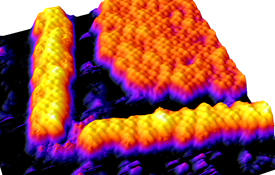

10/26/2020

© 2020 Hirofumi Oka
The electronic states of nanowires of a transition metal oxide go from being metallic to insulating on reducing the nanowire width, a team of AIMR researchers has shown1. In the future, such a metal–insulator transition could find application in phase-change memory devices and sensors.
Physicists find transition metal oxides fascinating systems to experiment with because their electrons interact strongly with each other, giving rise to a range of exotic effects such as high-temperature superconductivity and colossal magnetoresistance.
One-dimensional nanowires of transition metal oxides are expected to harbor even more interesting phenomena because their electronic states are subject to strong quantum fluctuations. Three-dimensional crystals and two-dimensional ultrathin films of transition metal oxides have been extensively studied, but it is difficult to fabricate one-dimensional nanowires using conventional nanofabrication techniques because of their relatively complex crystal structures.
Now, Hirofumi Oka of the AIMR at Tohoku University and his co-workers have succeeded in spontaneously forming nanowires of the transition metal oxide strontium vanadate (SrVO3) for the first time.
The team found that the electronic states of the nanowires depended strongly on the nanowire width, going from metallic to insulating as the nanowires got narrower. This finding mirrors what is observed in ultrathin films of strontium vanadate, which undergo a metal–insulator transition with decreasing thickness. While the mechanism has yet to be definitively determined, the researchers speculate that the electronic states in the nanowire may be quantized due to the quantum confinement caused by the low dimensionality of the nanowires.
The team used pulsed laser deposition to form the nanowires on the surface of a strontium vanadate ultrathin film (see image). This was unexpected, and the mechanism is currently being explored. “The spontaneous formation of one-dimensional strontium vanadate nanowires was very surprising,” notes Oka. “Despite the simple cubic perovskite structure of strontium vanadate, the crystal grows in only one direction.”
The state-of-the-art equipment at the AIMR was crucial for producing the nanowires. “The fabrication of the strontium vanadate nanowires was due in large part to our world-class low-temperature scanning tunneling microscope combined with pulsed laser deposition,” notes Oka. “This system allowed us to characterize the atomic structure in situ.”
In the future, the team intends to see if they can induce superconductivity in the nanowires. “It will be interesting to see if insulating strontium vanadate nanowires become superconducting on carrier doping because one-dimensional superconductors are expected to exhibit high-temperature superconductivity due to strong quantum fluctuations,” says Oka.
This research highlight has been approved by the authors of the original article and all information and data contained within has been provided by said authors.